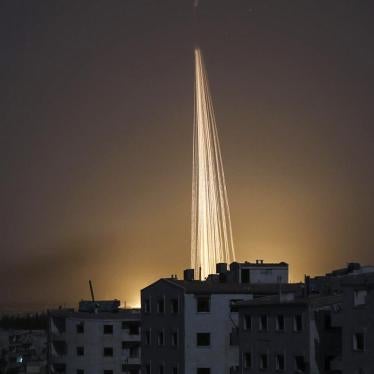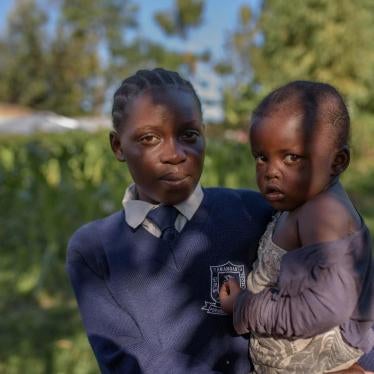The victims have been children playing outdoors, pedestrians walking down the street, workers pressing olive oil, and even families in their homes. While the world has been focused on whether the Syrian government has used chemical weapons, the Syrian government’s extensive use of cluster bombs has done devastating harm to civilians over the past year.
The town of Talbiseh, near Homs, has been repeatedly attacked with cluster bombs. After witnessing one cluster bomb strike a local inhabitant told Human Rights Watch, “I heard people screaming. I ran toward them and found out that one of the streets where the bomblets dispersed had people in it at the time. When I reached the house, I saw heavily wounded children inside. After helping out the injured we found three people killed in one of the nearby houses. They were from the same family.”
Dropped from aircraft or fired from the ground, cluster munitions break open in mid-air to disperse dozens and sometimes hundreds of small bomblets, also called submunitions. Concern over civilian casualties in Lebanon, Iraq, Afghanistan, and elsewhere from cluster munition attacks and their remnants led these and other countries to comprehensively ban these weapons in 2008. Yet Syria is not among the 112 nations that have signed the Convention on Cluster Munitions.
The last reported US use of a cluster munition was in Yemen on December 17, 2009, when one or more TLAM-D cruise missiles loaded with BLU-97 bomblets struck the hamlet of al-Majala in southern Abyan province, killing 41 civilians. Following the apparent chemical weapons attacks on August 21 near Damascus, though, there is concern that the US may use cluster munitions in a possible military intervention in Syria.
In the aftermath of the Syrian government’s cluster bomb attacks, there have been further casualties, particularly from bomblets that didn’t detonate during the attack but exploded later when handled. Some bomblets are shaped like silver tennis balls and attract the attention of curious children.
Initial reports that Syrian government forces were using cluster munitions emerged in mid-2012, then increased sharply in October as their air campaign on rebel-held areas intensified, and the use has continued this year. A review by Human Rights Watch for the annual Cluster Munition Monitor publication shows that at least 200 cluster munitions were used in nine of Syria’s 14 provinces between July 2012 and June 2013, although those are only the ones we were able to document. The actual number of strikes is probably higher.
The Syrian government’s response has been to deny it is using cluster munitions, dismiss the evidence as “untrue,” and claim that its armed forces do noteven possess the weapons.
The government’s denial on the face of it is puzzling, given the overwhelming evidence to the contrary. The explanation, it appears, is that cluster munitions have been so stigmatized by the treaty banning them that the Damascus government feels unable even to try to justify using these banned weapons.
Indeed, two years ago at an annual meeting of the Convention on Cluster Munitions hosted by Lebanon, a leading advocate for the treaty, the Syrian official representative described cluster munitions as “criminalized by humanity.” He said “we appreciate the international efforts to ban these weapons” but contended it was the standoff with Israel over the Golan Heights that had prevented Syria from joining.
In fact, most of the 80 nations that have yet to join the Convention on Cluster Munitions have expressed support for its humanitarian provisions, including the objective “to put an end to the human suffering and casualties caused by cluster munitions.”
Syria’s use of cluster munitions challenges the international norm prohibiting their use that the treaty aspires to achieve. Yet Syria has not succeeded in undermining the treaty. Since the adoption of the Convention on Cluster Munitions on May 30, 2008, there have been no confirmed reports or even allegations of new use of cluster munitions by any of the countries that have become part of it.
The vigor and determination that States Parties and signatories to the convention are demonstrating in carrying out the convention’s provisions is reinforcing its status as an increasingly powerful instrument of international law. France, the United Kingdom, and other countries that used cluster munitions in the past have relinquished the weapons by joining the ban convention and are rapidly destroying their stockpiles.
Syria’s cluster munitions use is exceptional. Most nations that remain outside the treaty are adhering to its provisions anyway. All but three of the countries known to produce cluster munitions that haven’t yet signed the treaty have said that they have never used the weapons. Israel, Russia, and the USA have not used cluster munitions since the convention became law in 2010.
Any US use of cluster bombs would contradict US statements condemning Syria’s cluster munitions use. It was one of 107 nations to vote for a resolution by the UN General Assembly in May that condemned a range of violations of international humanitarian law by Syrian government forces, including cluster munition use.
How to respond to use of these prohibited weapons will be a key topic for discussion at the annual meeting of countries supporting the treaty in Lusaka, Zambia on September 9.
At the 2011 meeting in Lebanon that Syria attended, more than 100 participating governments adopted a declaration of support for the Convention on Cluster Munitions that strongly condemned the use of cluster munitions by anyone, saying, “Together, we are compelled to do more to accomplish our collective goal – a world free of cluster munitions.”
That pledge is expected to be reaffirmed in Zambia with a strong message that cluster munitions are a banned weapon that should never be used again.
Meanwhile in Syria, civilians remain at risk from ongoing cluster bomb attacks as well as remnants, particularly unexploded bomblets. At some point, Syria’s nightmare will be over and the country can rebuild. One of the first steps must be the clearance and destruction of these and other explosive remnants of war, a task that will only become larger and take longer if the cluster bomb use continues.
Mary Wareham is advocacy director of the arms division at Human Rights Watch and a chief editor of the new report, Cluster Munition Monitor 2013.







